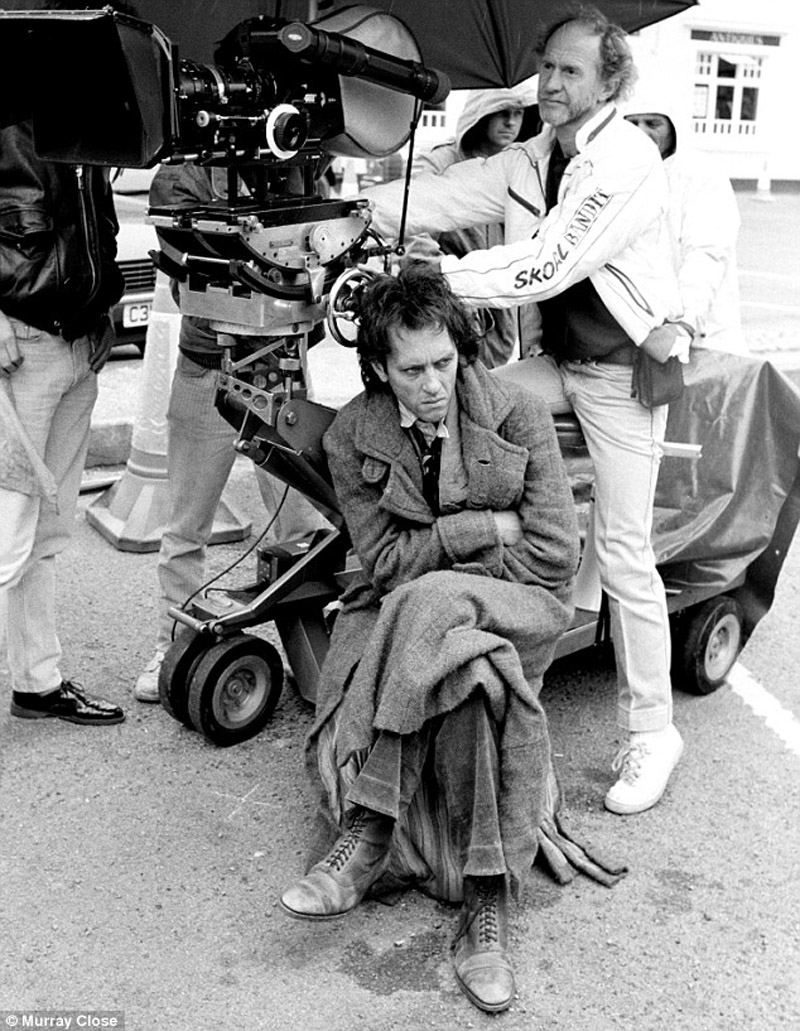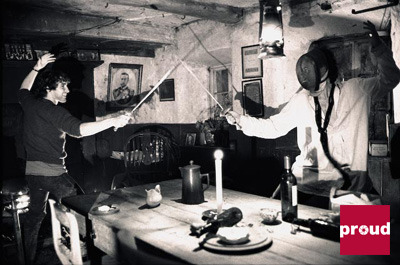A little while back Withnail Books was briefly home to a somewhat disturbing Victorian children's book, detailed here. Though not quite hitting the same heights of alternate reality morbidity, this recent arrival also makes one wonder quite what the Victorians were on when it came to coming up with nice little books for their kids.
The book's a bit long to show in toto here, but a few pages will suffice to sum it up. Silverland is a scarce volume (no non-POD copies around online currently), circa 1882, written by 'Mabel' and with intricate 'Pictures in Colours' by George Lambert. It's about Little May, a girl who, as is the case with most little girls, desperately wants to see some fairies...
So far, so good. Little May is certain about the fairies, even though she never sees any, and the story continues with descriptions of the tiny folks that live in the various types of flowers, and how May grows up to be nice to her brother's pet squirrel (I didn't understand that bit either). But what's this? Here's the final spread...
THE END. No fairies for you, love! And no proof that they weren't just in your head all along. All you get is to stare disconsolately into the fire. Those Victorians were harsh.
I collect books. I've got too many of them. So now I've opened a bookshop by mistake. In Penrith.
Thursday 31 October 2013
Wednesday 23 October 2013
A Baron Corvo Centenary Oddity: Ottoline Morrell's copy of Hadrian the Seventh
This week, October 25th to be precise, marks the centenary of the death of Frederick Rolfe. Better known by his self-invented title Baron Corvo, Rolfe is best described as the literary cult figure's cult figure. He was a writer of fiction, but also a photographer, artist and one of the great letter writers, especially to people he had fallen out with (which was, eventually, most people he met). W. H. Auden described him as "one of the great masters of vituperation." His Wikipedia entry will give you a quick overview, and if you want to know more, A. J. A. Symons' groundbreaking biography The Quest for Corvo is still in print. To commemorate the centenary, Withnail Books has listed several items of Corvine interest on eBay, including this interesting association copy, linking Rolfe's most famous work to the Bloomsbury Group.
It's a 1929 first printing of the Phoenix Library edition of Hadrian the Seventh, not an especially rare book in itself, but what makes it unique are the inscription and annotations.
Wikipedia will furnish you with detailed summaries of the lives of Morrell and Stephens if you're not familiar with them, but in brief:
Lady Ottoline Morrell was a friend, confidante and/or lover of many of the early 20th century's brightest literary lights, inlcuding Bertrand Russell, Aldous Huxley, D. H. Lawrence, Siegfried Sassoon and of course the 'Bloomsberries', inlcuding Duncan Grant and Lytton Strachey.
James Stephens was an Irish novelist and poet of smaller stature (both figuratively and literally: he was only 4 foot 10) who became part of Morrell's salon, much to the consternation of her other guests, due to his tendency to talk at people until they were bored stiff. Lytton Strachey dismissed him as 'a little gnome-like Irishman', and Ottoline's biographer Miranda Seymour notes that: 'It was not unusual for a visitor to find, say, Yeats, de la Mare and Eliot sitting in polite silence while Stephens told tales of leprechauns and, far too often, of his poverty-stricken childhood. (He was particularly fond of telling his audience that he had often had to fight with swans for a piece of bread...)'. One can only wonder what a meeting between Stephens and Rolfe could have been like... but I think both of them (and Ottoline) would be on my Fantasy Dinner Party list, for sure.
Despite his expertise at killing social occasions stone dead, Ottoline was very supportive of Stephens, and at some point (after 1929) he, presumably impressed with the novel, gave her this copy of Hadrian the Seventh as a gift. He inscribed it, in pen, 'With love to Ottoline Morrell / James Stephens'. Morrell, for her part, did not sign her own name in the book, but did, as was her wont, mark up in pencil passages or lines which appealed to her (only a few of which are pictured below). On the rear free endpaper, she even included page references to remind her of particular lines. Page 105's 'Acting as though the ideal were real, He made it real' being a favourite, it appears.
A small book with a lot of history. Here's a photo of them (with the translator S. S. Koteliansky on the left), from 1935.
Tuesday 15 October 2013
Withnail and I: The Finest Trivia Available To Humanity
 |
| Richard E. Grant, sitting down to enjoy his break between takes. |
This week saw the latest in the bi-annual (at least) viewings of Withnail and I in the Withnail Books household. Reason enough to celebrate with a list of 10 things you may, or may not have known about the film...
1. Writer/director Bruce Robinson makes several uncredited appearances on screen. That's him driving the Jag in longshot, and it's also him (not Michael Elphick) in the long shot of Jake the Poacher walking away from Crow Crag.
2. Talking of Michael Elphick, he was apparently blind drunk throughout the filming of his scene: his lines were shot a half-sentence at a time, as he couldn't say more than that without becoming incomprehensible.
3. Also blind drunk was Bruce Robinson, the night before shooting started. He began his first ever day on set as a film director with 'a bastard behind the eyes', after staying up half the night nursing a bottle of vodka in the George Hotel, Penrith.
4. The film's end credits feature a mention of 'Special Production Consultant Richard Starkey, MBE'. That's executive producer George Harrison giving his mate Ringo a nod, after Mr Starr took time to visit the set:
 |
| The Special Production Consultant, consulting. |
5. Murray Close, the Unit Photographer on the film, is today at the very top of the industry, with the likes of Harry Potter and The Hunger Games on his resume. He sells limited edition prints of his wonderful Withnail images on his website, here.
6. Though most of the 'country' locations were in Cumbria, the scenes in the film set in Penrith (Penrith!!) were not shot in the town. If you want to visit the actual place where Withnail demanded 'the finest wines available to humanity', you'll have to go to Stony Stratford, in Buckinghamshire. For a comprehensive guide to the filming locations, look no further than Tony Reeves' amazing site here.
7. In the aforementioned tearoom scene, we hear 'the proprietor' ask 'Mrs Blennerhasset' to phone the police. It's never been divulged, but here's guessing Bruce Robinson got that fabulous name from looking at a map of his filming location: there's a village called Blennerhasset in Northwest Cumbria. The place even has its own website.
8. There is a 'deleted scene', which is in the published script, and was shot, but has never been screened or included on any of the many, many home video releases of the film. It features Withnail and Marwood fencing in Monty's cottage. The film does include a moment with Withnail still holding his foil, but here's a photo from the deleted bit...
10. The 'lighter fluid' was vinegar. Considering Richard E. Grant thought it was going to be water, his breathless reaction was not acting. Also not-acting is his collapse into giggles during the tearoom scene: you can see him looking almost 'off camera', assuming he's ruined the take...
Chin chin!
Thursday 10 October 2013
Conan Doyle's The Lost World First Edition: An Early *In Universe* Book
There's been a move in the film and TV tie-in publishing world in recent years towards 'In Universe' books. That is to say, instead of non-fiction 'making of' or 'episode guide' titles (which have to fight to justify their existence these days alongside websites and DVD extras), a book is put together which presents itself as coming from within the world (or, yes, universe) of the story.
This recent Dark Knight Manual, full of 'documents from the Batcave', is a good example, as is this tie-in to the TV series Fringe — a book which is utterly impenetrable to non-fans, but endlessly fascinating and genuinely illuminating to those who followed all five seasons of the show. Then there are books which mix the 'behind the scenes' and 'in universe' approaches, like this Sherlock companion which peppers John Watson's 'Casefiles' (complete with snarky post-it notes from Sherlock himself) amongst the non-fiction stuff.
What's this got to do with The Lost World? Well, leafing through the copy of the rather wonderful Large Paper first edition Withnail Books currently has on eBay, it's evident that dear old Sir Arthur was playing the 'In Universe' game a century ago. The book was as much of a 'blockbuster' in its day as the film which nicked its name many decades later (the Michael Crichton one; by then there had already been several 'official' adaptations, including this one), and the 'Large Paper' edition was the 'Director's Cut/Special Edition' version of the novel, in a larger format, and with more illustrations than the standard trade edition. These images, a mixture of drawings, maps and photographs, are presented as documents sourced directly from 'the expedition', to go alongside the text, which is of course straight-facedly subtitled 'An account of the recent amazing adventures of Prof. George E. Challenger' et al.
What's really fun about the illustrations is that Conan Doyle himself got in on the act: that's him under a frankly outrageous false beard, pretending to be Professor Challenger. As well as the 'group photo' above, there's a Frontispiece and portrait photo of him as the Prof. Put those with the various other maps and 'photos', plus the stunning binding, featuring Iguanodon footprints, and you have a book which has that irresistible appeal of something which has been put together for fans, by fans. There were Conan Doyle and Dino geeks back in 1912, and this was for them. It's still very cool today.
Here it is in all its glory:
Wednesday 2 October 2013
Waistcoat Anecdotes and a Trip to the Moon: Baron Munchausen, Illustrated by Bichard, Warne, c1878
The 18 illustrations by Alphonse Adolf Bichard are fairly ubiquitous online (you can buy prints of them from the various 'it's out of copyright so we'll do what we like with it' art companies) but it's quite something to see them as they were originally presented, with colour printing which must have been top-flight, state-of-the-art stuff in its day. The photos below can't really do them justice, plus this is a big book, c13 inches x 9 1/2 inches.
Here's betting Terry Gilliam owns a copy of this edition: there's a lot in Bichard's art which appears to have influenced his ill-fated movie version. I really must watch it again. The first time I saw it, the projectionist missed out a whole reel, and I'm pretty sure mixed up the order of the others. That not many people in the audience noticed says something about the dreamlike nature of the film, and indeed the original tales.
Subscribe to:
Posts (Atom)




















































